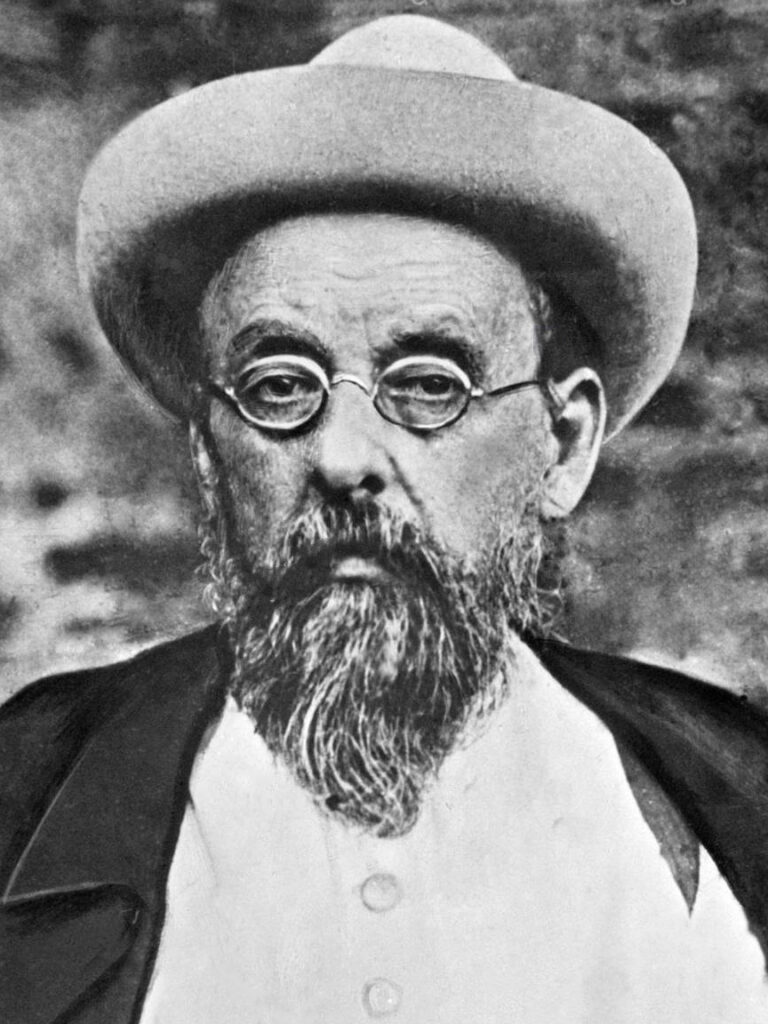The ‘Father of Astronautics and Rocket Dynamics.’
Konstantin Eduardovich Tsiolkovsky, scientist, inventor, and pioneer in rocket and space research, was born on September 17, 1857, in the village of Izhevskoye, in Ryazan Province, Russia, one of eighteen children. The son of a Polish forester who had moved to Russia, Konstantin lost his hearing at the age of ten due to scarlet fever. When he was fourteen, he was forced to drop out of school, ending his formal education though he continued to read voraciously. From 1873 to 1876, Konstantin Tsiolkovsky lived in Moscow. During this time he visited the main Moscow libraries, continuing his self-education.
An amateur inventor since childhood, at the age of seventeen, Tsiolkovsky first dreamed about the possibility of space flight. Inspired by the novels of Jules Verne, he started to consider what would be required to actually design a space vehicle. He proposed not only venturing into outer space but the establishment of permanent colonies there, for Tsiolkovsky believed humanity had to become a space civilization to survive.
From 1876 to 1879, Tsiolkovsky returned to live with his father in Vyatka and Ryasan but was consumed by his passion for physics and space exploration. He began to pursue his dreams by writing science fiction, including tales of interplanetary travel. While in Ryasan, he published his first scientific work, Astronomical Drawings, a schematic depiction of the Solar System, including the distances between planets. He soon introduced technical problems into his fictional writings, such as rocket control in moving into and out of gravitational fields. In September 1879, Tsiolkovsky became a math teacher in the public school system but devoted as much time to his research as possible.
From 1880 to 1892, Konstantin Tsiolkovsky taught school in Borovsk but continued to write about hot air balloons, life in outer space, aerodynamics, and cosmic philosophy. In 1883, he published Free Space, a consideration of the possibility of living in outer space and the effects of zero gravity. He included a drawing of a craft that could maneuver in space by firing reactive jets, had gyroscopic controls and airlocks to protect its crew and was one of the earliest designs of such a vehicle.
In 1892, Tsiolkovsky moved to Kaluga. Although he continued to teach school, it was here that he became a well-known scientist, writing and publishing most of his theories of space flight and interplanetary travels. Tsiolkovsky was one of the first researchers to deal with the theoretical requirements of space travel. He was the first to identify and arrive at solutions to a number of these issues with what is now known as “Tsiolkovsky Formula,” a fundamental principle that is still basic to astronautics. He first described the formula on May 10, 1897, but did not publish it until 1903, in the article “Exploration of the Universe with Reaction Machines.” In it, Tsiolkovsky provided detailed calculations that accurately described the state of weightlessness and the theoretical function of rockets in a vacuum. He demonstrated why rockets would be needed for space exploration, and also advocated the use of liquid propellants, one of the foundations of modern rocketry.
Konstantin Tsiolkovsky was made a member of the Soviet Academy of Science in 1919. He received a government pension in 1921 that allowed him to retire from school teaching and devote himself full time to writing about space travel. Tsiolkovsky wrote over 500 scientific papers, and, even though he never built any rockets himself, he influenced many young Russian engineers and designers. Tsiolkovsky lived long enough to see some of them begin to make his visionary concepts reality.
In 1926, Tsiolkovsky wrote Plan of Space Exploration, detailing his ideas from the very beginning of space travel until the far distant future, including interstellar travel and the colonization of the solar system and beyond. His 1929 book, The Space Rocket Trains, included his concept of multi-stage rockets, consisting of several separate rockets, one on top of another which he proved were necessary for any craft to reach escape velocity and fly to Earth orbit.
Tsiolkovsky’s most important book may be his 1932 work, Cosmic Philosophy, in which he discussed the far distant future of humanity, including the eventual conquest of space and mankind’s migration to the stars. Album of Space Travels, also published in 1932, shows his visionary ideas about life in space, including discussions of zero gravity, air pressure locking, space habitats, and rocket guidance. Tsiolkovsky also wrote science fiction books, including On The Moon (1895), Dreams of the Earth and Sky (1895), and Beyond the Earth (1920).
Konstantin Tsiolkovsky died at his home in Kaluga on September 19, 1935, at the age of seventy-eight. Shortly before his death, he wrote: “All my life I have dreamed that by my work mankind would at least be advanced a little.” He had furthered studies on many principles still used in rockets today: specific impulse to gauge engine performance, multistage boosters, fuel mixtures such as liquid hydrogen and liquid oxygen, the problems, and possibilities inherent in microgravity, the promise of solar power, and spacesuits for extravehicular activity. Significantly he never had the resources, or perhaps the inclination, to actually conduct rocket experiments, preferring to stay in the realm of theory.
Tsiolkovsky was buried with State honors in the Kaluga Cemetery. Asteroid 1590 Tsiolkovskaja is named in his honor and the house in Kaluga where he lived the last 30 years of his life is now the Konstantin E. Tsiolkovsky State Museum of the History of Cosmonautics.

